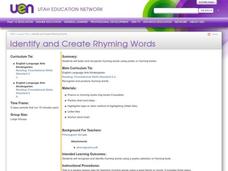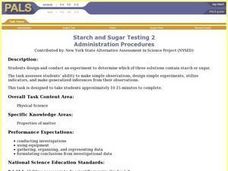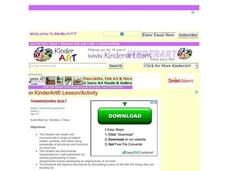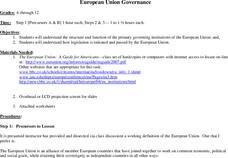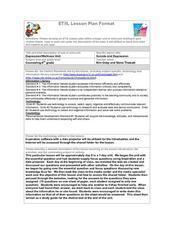Curated OER
Create a Food Chain
Students explore the food chain and the ways that animals depend on each other and on plants for food. They create a paper chain with different colors relating to carnivores and herbivores. The chains are linked to the sun to create a...
Curated OER
Identify and Create Rhyming Words
Students discuss rhyming word families and read stories that present those families in rhyme. They generate rhyming words, manipulate sentence strips to pair rhymes and sort pictures of rhyming words.
Curated OER
Trade -- Lesson Plan on the Theory of Comparative Advantage
Twelfth graders examine the theory of comparative advantage. They read an article about globalization and trading to answer questions promoted by the teacher. They develop their own examples of comparative advantage.
Curated OER
Stop Bullying: Take a Stand
Students examine the amount of bullying going on in today's society. They watch a video and discuss ways of dealing with a bully. They answer questions to end the activity.
Curated OER
1968: Year of Social Change and Turning Point in Vietnam and the United States
Eleventh graders examine the year 1968 in Vietnam and the United States. They work together to research events which they create a timeline. They also read primary source documents of veterans of the Vietnam War.
Curated OER
Women With a Pink
Students observe the portrait Woman with a Pink by Rembrandt. They determine how the artist uses symbols to portray his character. They write poems using symbols.
Curated OER
Flag Wars
Students consider how zoning policy shapes the character of neigborhoods. They see how zoning and loan policies have been used historically in the U.S. to benefit some people and discriminate against others. They examine tensions between...
Curated OER
Sadako and the 1000 Paper Cranes
Young scholars read the novel "Sadako and the 1000 Paper Cranes by Eleanor Coerr. They Reaearch Japanese Culture and design a presentation based on information from the Sadako Peace Club link.
Curated OER
Introduction to Selected Documents from the Roxcy Bolton Collection
Students listen to a guided imagery exercise that takes them back to 1969. They brianstorm ideas to try to discover why they would not be allowed to sit at an empty table at a Burdines lunch counter in 1969.
They read letters about the...
Curated OER
Measuring Elapsed Time
Fifth graders convert units within the same measurement system and be able to determine elapsed time. They are given a start time and an end time of a game. Students determine the amount of elapsed time from the data that is given.
Curated OER
Planetary Mobile
Students receive pre-cut templates of cardboard with appropriate diameters of each planet and the sun. They use multi-colored construction paper, scissors, yarn, and other art supplies to create their own models of planets. When students...
Curated OER
Cell Cycle Portfolio
Students work together in groups to complete various stations on the cycles of cells. Individually, they keep their completed work in a folder after following specific instructions on how to complete each experiment. They use the...
Curated OER
Power, Persuasion & Propaganda: Exploring Multiple Motives
Students recognize different motives even in non-commercial media. They analyze the role of media in a democratic society and wrestle with ethical issues concerning media and the public good. They create a media message with one or more...
Curated OER
The Battle for San Juan Hill: Santiago, Cuba, July 1, 1898
Eleventh graders design and create a poster, advertising for recruitment of volunteers to serve with Teddy Roosevelt in the 1st Volunteer Calvary Regiment. Students create a historical newspaper front page, from the time period, which...
Curated OER
Phases of Matter
Eighth graders practice using correct vocabulary and apply content knowledge related to phases of matter when answering questions about situations or observations from everyday life.
Curated OER
Unknown Liquids
Students must design and conduct an experiment to determine which unknown liquid has a greater density based on basic information about the liquids and containers. Students are given specific materials to work with.
Curated OER
Density of a Sinker
Eighth graders determine the density of a sinker by first finding the mass and then the volume using a graduated cylinder. Students must write the procedure they use to find the volume of the sinker then apply their data to follow-up...
Curated OER
Density of Minerals
Students determine the mass, volume, and density of two different mineral samples. Students show data and calculations as well as answer questions about the mineral identities.
Curated OER
Starch and Sugar Testing 2
Students design and conduct an experiment to determine which of three solutions contain starch or sugar. This task assess students' ability to make simple observations, design simple experiments, utilize indicators, and make generalized...
Curated OER
Rate of Solution
Eighth graders determine the amount of agitation necessary to dissolve various sized sugar particles. This task assess students' abilities to collect, organize, and interpret data, create appropriate graphs, predict future events based...
Curated OER
Starch and Sugar Testing 1
Eighth graders determine the presence of starch and sugar in unknown solutions. This task assesses students' abilities to observe, record and interpret data, classify, generalize/infer, construct data tables, and identify sugar and...
Curated OER
Thanksgiving Quilt
Second graders create individual "thankful" felt squares for use in a large classroom Thanksgiving quilt that can be put together using glue or hot glue. This great holiday lesson is based upon the book "Thanksgiving" by Miriam Nerlove.
Curated OER
European Union Governance
Young scholars explore the government functions of the European Union and how legislation is passed. As a class, students define the European Union and their interests in economic, political and social issues. Using the internet, young...
Curated OER
Suicide and Depression
Eighth graders research suicide and depression in teens. They are given an essential research question then create focus questions of their own before conducting their research. Using the Internet, they find answers to their questions...



